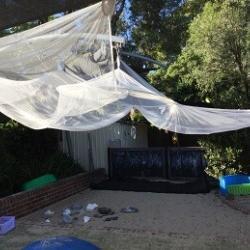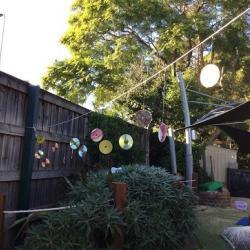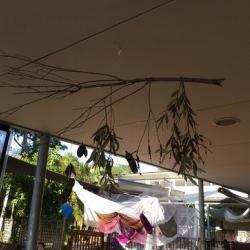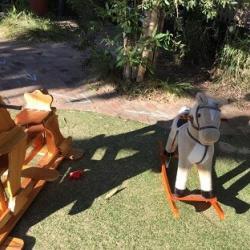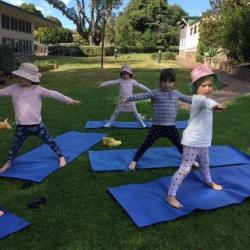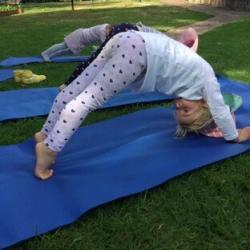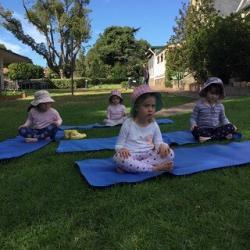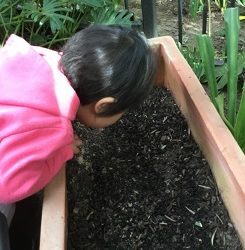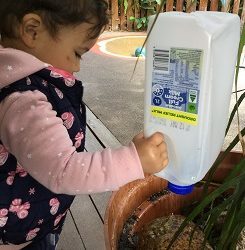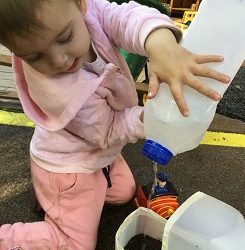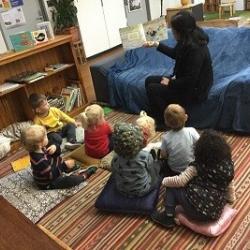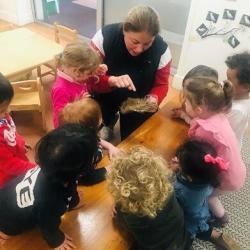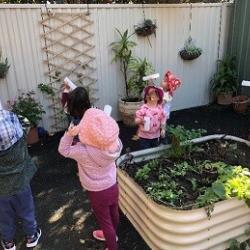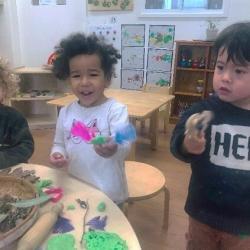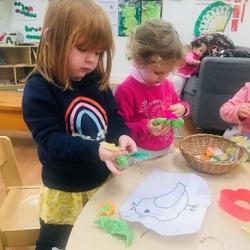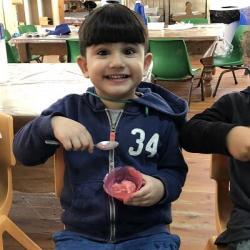Gorton House
In Gorton House infants many of the children and families are beginning to return to the centre after having some time at home due to COVID-19, and the educators are all so happy and excited to see children and their families returning. They wanted to do something exciting for the children who were returning, and recognised that many families have had to spend so much time indoors that it was important to spend more time outdoors. So, as a team, they spoke about ways they could make their outdoor physical environment more attractive. The outdoor environment has endless benefits for children’s development, including: helping them to generally be more physically active, stimulating their sensory skills and supporting the development of their fine and gross motor skills. Some additions they made to the outdoor environment included more colour, more hanging objects and more equipment, such as rocking horses, to extend on the children’s current interests.
After coming up with all these new ideas educators started to redecorate the outdoors with the support of children. They added more colours by using recycled materials such as nets, sarees, and CD discs. To represent and acknowledge people of the land, one educator created decorations with the children using dry parts of the gumtrees. All of these added so much energy to the outdoor area and made it look very inviting. When the children started to return educators saw them being captivated by the various changes in the environment. It was so nice and refreshing for educators to take a moment to get lost in the children’s excitement and to wonder about and appreciate with them some of the beautiful things in the environment that bring the children pleasure. This also provides the educators with endless learning possibilities to build upon, such as children seeing the wind blowing the fabric, watching the rainbows formed when sunlight hits the CDs and observing the natural beauty of recycled nature.
Johnson House
Yoga is an experience the children in Johnson House children regularly enjoy. The yoga poses they have been practicing recently have been based on ‘Cosmic Kids! Yoga’ and the story ‘We’re Going on a Bear Hunt’. As they did yoga this week, some of the children spoke about engaging in this experience with peers beyond Johnson House, or with their families.
With practice, the children were able anticipate the next poses in the sequence, and they modelled to one another how to execute each pose. Yoga supports the development of children’s muscle tone as well as strength throughout their bodies. It helps to maintain their flexibility and mobility in their joints and muscles. Yoga also helps children develop their sensory awareness as they notice what is going on in their bodies and minds while they’re in posture.
Murray House
Infants
In Murray House infants the children have been showing a growing interest in exploring the garden and dirt patch in the yard. Educators have responded to this emerging interest by inviting the children to go for a walk around the grounds, and providing them with unhurried opportunities to use their senses as they explore. Watering the garden is part of the children’s routine throughout the week, and they curiously watch the change in soil consistency when it is mixed with water. They touch the freshly watered garden soil and play with the mud, squeezing and squelching it in their hands, smelling it and rubbing it all over! An idea to create a small garden was introduced to the children, and they helped prepare the space for it. Children and educators cleared the garden patch, and put all of the dried leaves into the compost bin. This experience provided opportunities for children to exercise and to use their big muscles by digging the soil, scooping and transporting dried leaves, carrying water cans, and keeping the area tidy.
Educator Latha brought in some Marigold seeds and invited the children to help plant them. They looked at the visual prompts, with pictures of growing plants from a seed. The children show enthusiasm in watching over the sprouting seeds, and they have talked about being gentle with the seedlings as they watch them grow day by day. The children are involved in nurturing the young seedlings, adding water and ensuring they get enough sun during the day.
An upcycling project has been added into this learning as the group repurposes milk bottles to be used as watering cans. Excited chatter from the children has been heard: “Look! Tiny plant here…” Another child has been counting “One, two, seven…” How many seedlings could we see growing today? The children and educators observe the colours of various parts of the plants, the stalk, the leaves, and are hoping, they get to see a flower soon!
Toddlers
The mud pit has been very popular in Murray House toddlers this week. The children have been actively exploring the properties of mud, making mud castles, and ‘cooking’ for the educators and for one another. Educators play an active role in extending the children’s learning by capitalising on their interest. Through these play episodes, their receptive language and expressive language skills were actively fostered through various intentional teaching strategies. They were also supported to take turns, share resources, use verbal language to ask for a turn and wait. Thus their social skills and regulation skills were also being fostered.
This week also saw children involving in gardening and experimenting with various seed germination techniques. They assisted educators to put seeds directly into the soil and to put some on wet paper towels which were then placed in containers. The children will revisit these seeds over time to compare their findings on how the seeds germinate. These experiences encourage children to develop their observations skills and to use verbal language to communicate their observations and share their ideas with their peers.
Additionally, many social games, counting games, and story book activities have been introduced throughout the day to encourage children’s friendship development. This week’s most popular story book was ‘We’re Going on a Bear Hunt’ by Michael Rosen and Helen Oxenbury. The children enjoy the repetition in this book as it helps them to predict and ‘read’ the story.
Rigby House
Birds and Nests
The children at Rigby House have been interested in the birds in their environment. Birds often fly onto the fences, into the playground and sometimes even onto the verandah. These opportunities to observe birds more closely always delight the children.
Recently, one of the staff in Rigby House found an old bird’s nest and showed it to the children. They examined it closely, observing the materials that had been used to make the nest. The children have become very interested in nests and how they are made and how birds use them.
Educators are supporting the children’s learning by providing learning areas, experiences and stories about nests, eggs and birds. The children are birdwatching daily, using cylinders as binoculars to spot birds in the trees. They are demonstrating their understanding of bird anatomy and nests, by creating their own birds, nests and eggs with playdough, natural materials and feathers.
Robinson House
Through conversations and social interactions between educators and children in Robinson House, they have discovered a shared interest in ice cream. Children and educators shared what their favourite flavours are, such as mint chocolate, watermelon, rainbow and bubblegum, through a song which allowed the children to express their ideas. This sparked a project between the children and educators, as they engaged in a variety of experiences surrounding their love for ice cream!
Ice cream is known generally to be a ‘sometimes’ food, with one child sharing that “there’s lot of sugar in ice cream”. However, educator Anne has challenged this idea by engaging the children in cooking experiences in which they have been making ice cream just using fruit. They made banana ice cream, by peeling and chopping bananas, freezing them overnight and then blending them. It was a long process, but the quietness in the room as the children enjoyed their ice creams, along with the “mmmm”s and ‘Yummy’ comments and smiles on their faces said it all! They continued to have conversations about how their banana ice cream was healthier as it was just made of bananas, what other fruits they could use next time. They also made a song about how to make this banana flavoured ice cream.]
One of the flavours suggested by the children was watermelon, so they tried making a watermelon sorbet, which followed the same process as making the banana ice cream. Perhaps reinforced by the song they had made up, the children recalled the process of making banana ice cream, and they chopped the watermelon, put in the freezer, blended it the next day and ate it! The children said, “It’s freezing!” when they had their first bite of the watermelon sorbet, but they seemed to enjoy it. These experiences have been great opportunities for the children to develop their awareness of nutrition and healthy eating, and to also develop their fine motor skills as they participated in the ice cream making process.
The children’s interest in ice cream continues to be evident in their pretend play as they pretend to sell ice cream! Educators are in the process of transforming our socio-dramatic corner into an ice-cream shop to further support children’s play and learning, so stay tuned!
